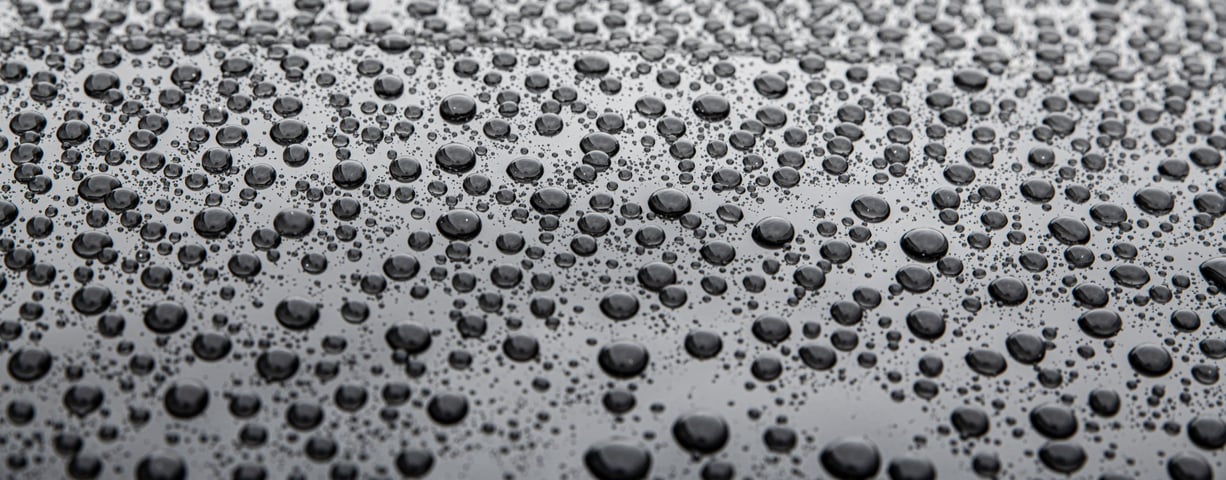
When talking about contact angles, most typically people mean the angle that is measured when a droplet is sitting on a surface. This contact angle is called a static contact angle. Static in a sense that we are looking at the drop at a point when the baseline of the droplet is stable. But why has the drop taken that shape? Is that the only possible contact angle on that surface or could other angles be measured as well? Which is the correct one?
There has been a long debate on the validity of the static contact angle. In empirical studies, it has been shown that instead of having one stable contact angle, most surfaces exhibit a wide range of contact angle values. The maximum contact angle for the surface is termed advancing contact angle and the minimum receding contact angle. The difference between the two is called contact angle hysteresis.
It is widely accepted that practically all real surfaces exhibit contact angle hysteresis. Contact angle hysteresis arises from chemical and topological non-idealities. In theory, there is no contact angle hysteresis on an ideal surface. An ideal surface is chemically homogenous, rigid, flat on an atomic scale, and does not interact with the liquid used for contact angle measurements in any way. In practice, it has been shown that the roughness of the nanometer scale can contribute to contact angle hysteresis. Also, chemical heterogeneity as small as 6-12 nm still causes contact angle hysteresis. With these in mind, it is safe to say that an ideal surface hardly exists, and the contact angle hysteresis caused by surface roughness and chemical heterogeneity is always present.
This also means that there is no equilibrium contact angle, and thus the static contact angle values are somewhat meaningless. Instead, one should always measure the advancing (highest possible contact angle) and the receding contact angle (the lowest possible contact angle) to get the true picture of the surface wettability.
The advancing angle is measured when the liquid wets the previously dry surface. This is typically done with the so-called needle method, where water is gradually applied on the surface. When the contact line starts to move, the advancing contact angle can be measured. The advancing angle is thought to be more sensitive to hydrophobic components of the solid surface. Advancing contact angles are then utilized when the surface cleanliness of the hydrophilic surface is being evaluated as most of the contaminants are organic and thus hydrophobic. The measured advancing contact angle is expected to correlate well with the tendency of the surface to either attract or repel the probing liquid.
The receding angle describes the de-wetting state as the contact angle is measured when the liquid is withdrawn. The receding angle is thought to be more sensitive to the hydrophilic components of the solid surface. The measured receding contact angle has been shown to correlate well with the adhesion force between the solid and the liquid.
Advancing and receding contact angles are mostly measured with water, but some authors propose to do the measurement also with completely dispersive liquid, for example, hexadecane or di-iodomethane. The measurement of advancing and receding contact angle with water and either of the completely dispersive liquids will give all the information needed to evaluate the surface wettability. Advancing and receding contact angle values, when measurements are properly done, are also completely non-controversial compared to for example surface free energy calculations.
If you are interested in how to measure advancing and receding contact angles in practice, please check out the short webinar below.
Receding contact angle is the lowest possible contact angle on a given surface. Receding angle is measured on previously wetted surface.
Contact angle hysteresis can tell you about the homogeneity of your surface coating.
Due to a wide range of applications, the measurement of wettability, i.e., the contact angle measurement can be done with several different methods.
More and more research interest is being put on functional coatings. New measurement techniques are required to evaluate them.
Contact angle hysteresis is often measured with so-called tilting cradle or plate method. The measurement can be done either manually or automatically.
Dynamic contact angle measurements with the needle method has been automated for reliable and repeatable results.
Contact angle hysteresis can be measured with optical (needle and tilting methods) and force (Wilhelmy method) tensiometers.
Contact angle hysteresis (CAH) is an important physical phenomenon. When you look through the window on a rainy day, you have probably noticed that some of the water droplets stick to the glass even though gravity is pulling them down. The phenomenon can be explained by contact angle hysteresis.
